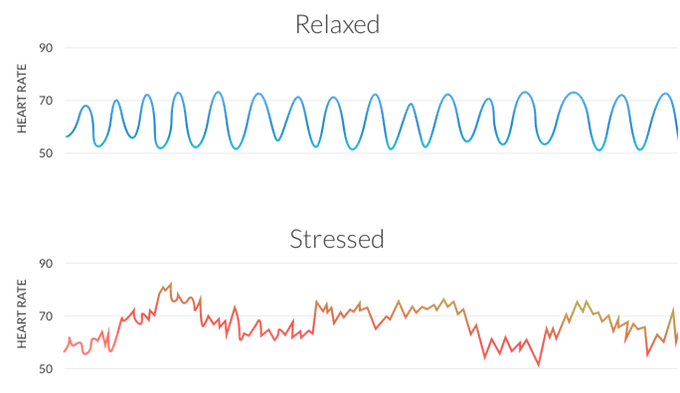Growing research supports Heart Rate Variability (HRV) biofeedback training to lower stress and anxiety, increase sports performance
 What’s HRV? An important health metric every golfer should pay attention to (Golf.com):
What’s HRV? An important health metric every golfer should pay attention to (Golf.com):
As amateur golfers, we’d love to play like the pros. There’s no doubt that you would trade your banana slice for Dustin Johnson’s penetrating 300-yard drive down the middle of the fairway or Collin Morikawa’s impeccable ball striking in a heartbeat.
Unfortunately, we have limiting factors — be they physical ability, money, time or something else. But that doesn’t mean we can’t adopt a few things the Tour pros do to stay in shape in our own lives.
For one, Tour players, and other professional athletes, are now tracking their Heart Rate Variability (HRV) to help them measure their recovery and peak at the right times on the course … If you’re unfamiliar with HRV, it’s the variance in time between the beats of your heart.
For example, if your heart rate is 60 beats per minute, that doesn’t actually mean your heart is beating once every second. During that one minute span, there may be 0.9 seconds between two beats and 1.2 seconds between two other beats. The larger this variability is, the more likely your body is to be recovered and ready to perform at a high level on the course.
This is because HRV is a result of your parasympathetic (deactivating) nervous system and sympathetic (activating) nervous system simultaneously sending signals to your heart.
Recent studies on Heart Rate Variability (HRV), Health and Sports Performance:
Heart Rate Variability: An Old Metric with New Meaning in the Era of using mHealth Technologies for Health and Exercise Training Guidance. Part One: Physiology and Methods (Arrhythmia & Electrophysiology Review).
- Abstract: The autonomic nervous system plays a major role in optimising function of the cardiovascular (CV) system, which in turn has important implications for CV health. Heart rate variability (HRV) is a measurable reflection of this balance between sympathetic and parasympathetic tone and has been used as a marker for cardiac status and predicting CV outcomes. Recently, the availability of commercially available heart rate (HR) monitoring systems has had important CV health implications and permits ambulatory CV monitoring on a scale not achievable with traditional cardiac diagnostics. The focus of the first part of this two-part review is to summarise the physiology of HRV and to describe available technologies for HRV monitoring. Part two will present HRV measures for assessing CV prognosis and athletic training.
Part Two: Prognosis and Training
- Abstract: It has been demonstrated that heart rate variability (HRV) is predictive of all-cause and cardiovascular mortality using clinical ECG recordings. This is true for rest, exercise and ambulatory HRV clinical ECG device recordings in prospective cohorts. Recently, there has been a rapid increase in the use of mobile health technologies (mHealth) and commercial wearable fitness devices. Most of these devices use ECG or photo-based plethysmography and both are validated for providing accurate heart rate measurements. This offers the opportunity to make risk information from HRV more widely available. The physiology of HRV and the available technology by which it can be assessed has been summarised in Part 1 of this review. In Part 2 the association between HRV and risk stratification is addressed by reviewing the current evidence from data acquired by resting ECG, exercise ECG and medical ambulatory devices. This is followed by a discussion of the use of HRV to guide the training of athletes and as a part of fitness programmes.
The effect of heart rate variability biofeedback training on stress and anxiety: a meta-analysis (Psychological Medicine). From the Abstract:
- Background: Some evidence suggests that heart rate variability (HRV) biofeedback might be an effective way to treat anxiety and stress symptoms. To examine the effect of HRV biofeedback on symptoms of anxiety and stress, we conducted a meta-analysis of studies extracted from PubMed, PsycINFO and the Cochrane Library.
- Conclusions: HRV biofeedback training is associated with a large reduction in self-reported stress and anxiety. Although more well-controlled studies are needed, this intervention offers a promising approach for treating stress and anxiety with wearable devices.
Effect of Heart Rate Variability Biofeedback on Sport Performance, a Systematic Review (Applied Psychophysiology and Biofeedback )
- Abstract: Aim is to determine if the training with heart rate variability biofeedback allows to improve performance in athletes of different disciplines. Methods such as database search … All studies had a small sample size (range from 1 to 30 participants). In 85.71% of the studies (n=6) the athletes enhanced psychophysiological variables that allowed them to improve their sport performance thanks to training with heart rate variability biofeedback. Despite the limited amount of experimental studies in the field to date, the findings suggest that heart rate variability biofeedback is an effective, safe, and easy-to-learn and apply method for both athletes and coaches in order to improve sport performance.
News in Context:
- Can biofeedback-based videogames help children better manage stress? Magellan Health and Mightier secure $2 million NIMH grant to investigate
- Six tips to build resilience and prevent brain-damaging stress
- Solving the Brain Fitness Puzzle Is the Key to Self-Empowered Aging
- Ten neurotechnologies about to transform brain enhancement & health
- Five reasons the future of brain enhancement is digital, pervasive and (hopefully) bright


